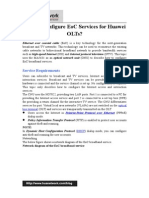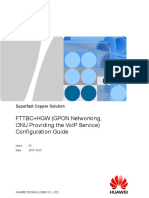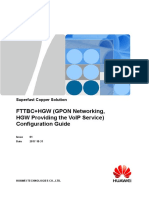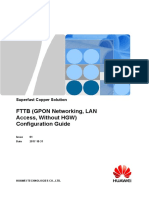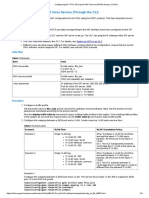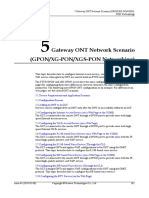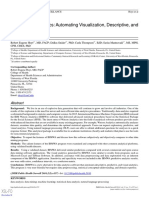0 ratings0% found this document useful (0 votes)
76 views54 pagesCOMANDOS Olt Huawei
Uploaded by
Carlos JúniorCopyright
© © All Rights Reserved
We take content rights seriously. If you suspect this is your content, claim it here.
Available Formats
Download as ODT, PDF, TXT or read online on Scribd
0 ratings0% found this document useful (0 votes)
76 views54 pagesCOMANDOS Olt Huawei
Uploaded by
Carlos JúniorCopyright
© © All Rights Reserved
We take content rights seriously. If you suspect this is your content, claim it here.
Available Formats
Download as ODT, PDF, TXT or read online on Scribd
You are on page 1/ 54
1.
Configure a DBA profile.
huawei(config)#dba-profile
huawei(config)#dba-profile
huawei(config)#dba-profile
huawei(config)#dba-profile
max 16384
huawei(config)#dba-profile
max 16384
2.
add
add
add
add
profile-name
profile-name
profile-name
profile-name
fttb_dba_mngt type1 fix 1024
fttb_dba_voip type1 fix 4096
fttb_dba_hsi type4 max 524288
fttb_dba_vod type3 assure 8192
add profile-name fttb_dba_iptv type3 assure 8192
Configure an ONU line profile.
a.
Add GPON ONU line profile 10 fttb(c).
huawei(config)#ont-lineprofile gpon profile-id 10 profile-name fttb(c)
NOTE
The ID of the line profile to be created must not exist in the system, and the line
profile must be
created according to the data plan. In this example, line profile 10 is used.
b.
In the line profile mode, bind the T-CONT to the DBA profile.
huawei(config-gpon-lineprofile-10)#tcont
huawei(config-gpon-lineprofile-10)#tcont
huawei(config-gpon-lineprofile-10)#tcont
huawei(config-gpon-lineprofile-10)#tcont
huawei(config-gpon-lineprofile-10)#tcont
c.
4
5
6
7
8
dba-profile-name
dba-profile-name
dba-profile-name
dba-profile-name
dba-profile-name
fttb_dba_mngt
fttb_dba_voip
fttb_dba_hsi
fttb_dba_vod
fttb_dba_iptv
In the line profile mode, create a GEM port for each T-CONT.
QoS policies must be configured for various service flows. For details about QoS
data plan, see 2.2 Principle of QoS Planning.
huawei(config-gpon-lineprofile-10)#gem add 11 eth tcont 4
//Create
GEM port 11 for T-CONT 4. Use the same method to create other GEM ports.
huawei(config-gpon-lineprofile-10)#gem add 12 eth tcont 5
huawei(config-gpon-lineprofile-10)#gem add 13 eth tcont 6
huawei(config-gpon-lineprofile-10)#gem add 14 eth tcont 6
//Create
two GEM ports for the Internet access service. The reason is as follows:
Each GEM port maps up to 8 ONU-side service flows, and a total of 16
Internet access service flows are configured on the ONU in the following
section.
huawei(config-gpon-lineprofile-10)#gem add 15 eth tcont 7
huawei(config-gpon-lineprofile-10)#gem add 16 eth tcont 8
d.
Configure mapping between the GEM port and the ONU-side service.
Set the mode for mapping a GEM port to an ONU-side service to VLAN (default
mode). Map management service flows with C-VLAN 8 to GEM port 11, voice
service flows with C-VLAN 200 to GEM port 12, Internet access service flows with
C-VLANs 1001-1016 to GEM ports 13 and 14, VoD service flows with C-VLAN
300 to GEM port 15, and IPTV service flows with C-VLAN 1000 to GEM port 16.
huawei(config-gpon-lineprofile-10)#gem
huawei(config-gpon-lineprofile-10)#gem
huawei(config-gpon-lineprofile-10)#gem
......
huawei(config-gpon-lineprofile-10)#gem
huawei(config-gpon-lineprofile-10)#gem
......
huawei(config-gpon-lineprofile-10)#gem
huawei(config-gpon-lineprofile-10)#gem
huawei(config-gpon-lineprofile-10)#gem
e.
mapping 11 0 vlan 8
mapping 12 0 vlan 200
mapping 13 0 vlan 1001
mapping 13 7 vlan 1008
mapping 14 0 vlan 1009
mapping 14 7 vlan 1016
mapping 15 0 vlan 300
mapping 16 0 vlan 1000
After the configuration is completed, run the commit command to make the
configured parameters take effect.
huawei(config-gpon-lineprofile-10)#commit
huawei(config-gpon-lineprofile-10)#quit
Issue 01 (2017-10-31)
Huawei Proprietary and Confidential
Copyright © Huawei Technologies Co., Ltd.
35Superfast Copper Solution
FTTBC (GPON Networking, xDSL Access, Without
HGW) Configuration Guide
3.
3 FTTB/C Networking (GPON Networking, xDSL Access,
Without HGW)
(Optional) Add an alarm profile.
– The ID of the default GPON alarm profile is 1. The thresholds for all the alarm
parameters in the default alarm profile are 0, which indicates that no alarm is
generated.
– In this example, the default alarm profile is used. Therefore the configuration of the
alarm profile is not required.
Step 2 Add an ONU to an OLT.
Assume that the ID of GPON port 0/2/1 is 1, SN is 32303131B39FD641,
management mode
is SNMP, and the bound line profile is fttb(c). Connect the ONU to such a GPON port
through
the optical splitter.
There are two modes to add an ONT: add an ONT offline and confirm an
automatically
discovered ONU.
l
Add an ONU offline.
huawei(config)#interface gpon 0/2
huawei(config-if-gpon-0/2)#ont add 1 ontid 1 sn-auth 32303131B39FD641
snmp ont-lineprofile-name fttb(c)
l
Confirm an automatically discovered ONU.
huawei(config)#interface gpon 0/2
huawei(config-if-gpon-0/2)#port 1 ont-auto-find enable
huawei(config-if-gpon-0/2)#display ont autofind 1
huawei(config-if-gpon-0/2)#ont confirm 1 ontid 1 sn-auth 32303131B39FD641
snmp ont-lineprofile-name fttb(c)
1.
(Optional) Bind the alarm profile to the ONU.
By default, alarm profile 1 is automatically bound to an ONU. A non-default alarm
profile is bound manually only when the default one does not meet the requirement.
In this example, the default alarm profile 1 is used and therefore the configuration of
the
alarm profile is not required.
Step 3 Check the ONU status.
After an ONU is added, run the display ont info command to query the current status
of the
ONU. Ensure that Config flag of the ONU is active, Run State is online, and Config
state is
normal.
huawei(config-if-gpon-0/2)#display ont info 1 1
---------------------------------------------------------------------
F/S/P
: 0/2/1
ONT-ID
:1
Control flag
: active
//The ONU is activated.
Run state
: online
//The ONU is online.
Config state
: normal
//The ONU configurations are recovered
normally.
...//The rest of the response information is not provided here.
huawei(config-if-gpon-0/2)#quit
----End
Follow-up Procedure
When Config state is failed, Run state is offline, or Match state is mismatch:
l If Control flag is deactive, run the ont active command in GPON mode to activate
the
ONU.
l If Run state is offline, a physical line may be broken or the optical module may be
damaged. Check the line and the optical module.
Issue 01 (2017-10-31)
Huawei Proprietary and Confidential
Copyright © Huawei Technologies Co., Ltd.
36Superfast Copper Solution
FTTBC (GPON Networking, xDSL Access, Without
HGW) Configuration Guide
3 FTTB/C Networking (GPON Networking, xDSL Access,
Without HGW)
l If Config state is failed, the configured ONU capability exceeds the actual ONU
capability. In this case, run the display ont failed-configuration command in the
diagnose mode to check the failed configuration item and the failure cause. Then,
rectify
the fault accordingly.
l If the ONU does not match (Match state is mismatch), the port types and number of
ports do not match the actual port types and number of ports supported by the ONU.
In
this case, run the display ont capability command to query the actual capability of the
ONU, and then select one of the following modes to modify the ONU configuration:
– Create a proper ONU profile according to the actual capability of the ONU, and
then run the ont modify command to modify the configuration data of the ONU.
– Modify the ONU profile according to the actual capability of the ONU and save the
modification. Then, the ONU automatically recovers the configuration successfully.
3.4 Configuring the Management Channel Between the
OLT and the ONU
After the inband management channel between the OLT and the ONU is configured
and
available, you can log in to the ONU from the OLT to configure the ONU.
Data plan
Item Data Remarks
Management VLAN
and management IP
address on the OLT
side Management VLAN ID: 8 Management VLAN
and management IP
address on the ONU
side Management VLAN ID: 8 To configure the MDU from the OLT
by remote logging in to the MDU, the
management VLAN of the OLT and
that of the MDU must be the same,
and the management IP address of the
OLT and that of the MDU must be in
the same network segment.
Management VLAN type:
smart VLAN
Inband management IP
address: 192.168.50.1/24
Management VLAN type:
smart VLAN
Inband management IP
address: 192.168.50.2/24
Procedure
Step 1 Configure the inband management VLAN and IP address of the OLT.
Configure the inband management VLAN to 8, VLAN priority to 6, and the IP
address to
192.168.50.1/24.
huawei(config)#vlan 8 smart
huawei(config)#port vlan 8 0/19 0
huawei(config)#vlan priority 8 6
huawei(config)#interface vlanif 8
huawei(config-if-vlanif8)#ip address 192.168.50.1 24
huawei(config-if-vlanif8)#quit
Step 2 Configure the inband management VLAN and IP address of the ONU.
Issue 01 (2017-10-31)
Huawei Proprietary and Confidential
Copyright © Huawei Technologies Co., Ltd.
37Superfast Copper Solution
FTTBC (GPON Networking, xDSL Access, Without
HGW) Configuration Guide
3 FTTB/C Networking (GPON Networking, xDSL Access,
Without HGW)
Configure the static IP address of the ONU to 192.168.50.2/24, gateway to
192.168.50.254,
and the management VLAN ID to 8 (the same as the management VLAN of the
OLT).
huawei(config)#interface gpon 0/2
huawei(config-if-gpon-0/2)#ont ipconfig 1 1 static ip-address 192.168.50.2 mask
255.255.255.0 gateway
192.168.50.254 vlan 8
huawei(config-if-gpon-0/2)#quit
Step 3 Configure an inband management service port.
Configure the management service port ID to 1, management VLAN ID to 8, GEM
port ID to
11, and user-side VLAN ID to 8. The OLT does not limit inband management service
flows.
Therefore, it is recommended that you use default traffic profile 6.
huawei(config)#service-port 1 vlan 8 gpon 0/2/1 ont 1 gemport 11 multi-service
user-vlan 8 rx-cttr 6 tx-cttr 6
Step 4 Confirm that the management channel between the OLT and the ONU is
available.
l On the OLT, run the ping 192.168.50.2 command to check the connectivity between
the
OLT and the ONU. The ICMP ECHO-REPLY packet from the ONU should be
received.
l On the OLT, You can remotely log in to the ONU to perform the configuration.
----End
3.5 Configuring the Service Channel Between the OLT
and the ONU
Various service flows can be configured on the OLT for different services so that
service
packets on the ONU can be forwarded at Layer 2 according to the planned VLAN
and
forwarding policies.
Context
Service flows can be added in two modes, as described in Table 3-3. Select either
mode as
required.
Table 3-3 Adding service flows
Issue 01 (2017-10-31)
Mode Command Remarks
Add service flows
one by one. service-port -
Add service flows
in batches. multi-service-port You need to specify the ontid +
gemindex to identify a service
flow and ensure that the number of
GEM ports is the same as the
number of VLANs on the user
side.
Huawei Proprietary and Confidential
Copyright © Huawei Technologies Co., Ltd.
38Superfast Copper Solution
FTTBC (GPON Networking, xDSL Access, Without
HGW) Configuration Guide
3 FTTB/C Networking (GPON Networking, xDSL Access,
Without HGW)
Data plan
Item Data Remarks
Internet access
service OLT VLAN ID: Assume that the split ratio of the
optical splitter is 1:32, the ONU is
connected to port 1 on the optical
splitter using the optical cable, and
the user PC is connected to port 1
on the ONU. In this case, the inner
VLAN is 258 according to the
formula for calculating the inner
VLAN.
l C-VLAN ID: 256 x GPON
port ID + 32 x Split ratio x
(Splitter port ID - 1) +
ONU port ID + 1
l S-VLAN: VLAN ID 100
and attribute stacking
Upstream VLANs of the
ONU: 1001-1016
VoIP service
Service flow ID: 101 For details about the data plan, see
2.3 Principle of Internet Access
Service Data Plan.
OLT VLAN ID (VLAN
transparently transmitting the
ONU service): 200 For details about the data plan, see
2.4 Principle of VoIP Service
Data Plan.
ONU VLAN ID: 200
Service flow ID: 201
Procedure
l
Configure a channel for the Internet access service.
a.
Configure the service VLAN and add the upstream port to this VLAN.
Configure the S-VLAN ID to 100, VLAN type to smart VLAN, and VLAN
attribute to stacking. Add upstream port 0/19/0 to VLAN 100.
huawei(config)#vlan 100 smart
huawei(config)#vlan attrib 100 stacking
huawei(config)#port vlan 100 0/19 0
b.
Configure the corresponding traffic profile.
The 802.1p priority for the Internet access service is 0 and the traffic profile is
unlimited. You can run the display traffic table ip command to query the traffic
profile in the system. Use traffic profile 6.
huawei(config)#display traffic table ip from-index 0
c.
Configure service flows to receive and transparently transmits the Internet access
service from the ONU.
According to the data plan,
n For the OLT: The S-VLAN ID is 100, inner VLAN ID is 258. The user-side
VLAN ID of the OLT is the upstream VLAN ID of the ONU, that is, 1001.
The Internet access service uses GEM port 13.
n For the ONU: The upstream VLAN ID is 1001.
huawei(config)#service-port 101 vlan 100 gpon 0/2/1 ont 1 gemport 13
multi-service
user-vlan 1001 tag-transform translate-and-add inner-vlan 258 rx-cttr 6
tx-cttr 6
Issue 01 (2017-10-31)
Huawei Proprietary and Confidential
Copyright © Huawei Technologies Co., Ltd.
39Superfast Copper Solution
FTTBC (GPON Networking, xDSL Access, Without
HGW) Configuration Guide
l
3 FTTB/C Networking (GPON Networking, xDSL Access,
Without HGW)
Configure a channel for the VoIP service.
a.
Configure the service VLAN and add the upstream port to this VLAN.
Configure the S-VLAN ID to 200 and VLAN type to smart VLAN. Add upstream
port 0/19/0 to VLAN 200.
huawei(config)#vlan 200 smart
huawei(config)#port vlan 200 0/19 0
b.
Configure the corresponding traffic profile.
The 802.1p priority of the VoIP service is 5 and the traffic profile is unlimited. You
can run the display traffic table ip command to query the traffic profile in the
system. If the existing traffic profile does not meet data plan requirements, a new
traffic profile is required.
New traffic profile 9 is added. In the command execution, priority-policy is local-
setting, which indicates that service packets are scheduled by the priority specified
in the traffic profile.
huawei(config)#traffic table ip index 9 cir off priority 5 priority-
policy local-setting
c.
Configure service flows to receive and transparently transmits the VoIP service
from the ONU.
According to the data plan,
n For the OLT: The S-VLAN ID is 200. The user-side VLAN ID of the OLT is
the upstream VLAN ID of the ONU, that is, 200. The VoIP service uses GEM
port 12.
n For the ONU: The upstream VLAN ID is 200.
huawei(config)#service-port 201 vlan 200 gpon 0/2/1 ont 1 gemport 12
multi-service
user-vlan 200 rx-cttr 9 tx-cttr 9
----End
3.6 Configuring the Internet Access Service (ADSL2+
Access, on the ONU)
This topic describes how to configure the Internet access service for ADSL2+ users
on an
optical network unit (ONU).
Context
The description of this topic is based on the mode below.
Issue 01 (2017-10-31)
Mode Query Method
ADSL2+ common mode
(RFC2662 mode) On the ONU:
huawei(config)#diagnose
huawei(diagnose)%%display xdsl mode
-------------------------------------------
ADSL Current mode : rfc2662
VDSL Current mode : tr129
--------------------------------------------
Huawei Proprietary and Confidential
Copyright © Huawei Technologies Co., Ltd.
40Superfast Copper Solution
FTTBC (GPON Networking, xDSL Access, Without
HGW) Configuration Guide
3 FTTB/C Networking (GPON Networking, xDSL Access,
Without HGW)
ADSL2+ ports working in normal mode (that is, RFC 2662 mode) need to bind an
ADSL2+
line profile and an ADSL2+ alarm profile. For the functions and configurations of
each
profile, see Table 3-4.
Table 3-4 ADSL2+ profile
Profile
Type Function Configuration
ADSL2+
line
profile An ADSL2+ line profile provides the
following parameters: The system has four default profiles
(profile 1, profile 1022, profile 1023,
and profile 1024) for activation of
ADSL2+ ports in different conditions.
l ADSL/ADSL2+ working mode
l Channel mode
l Upstream/Downstream line rate l Profile 1 is used for activation of
common ADSL ports.
l Upstream/Downstream interleave
depth l Profile 1022 is used for fast
activation of ADSL ports.
l Noise margin l Profile 1023 is used for long-reach
activation of existing ADSL ports.
When an ADSL2+ port is activated,
the central office (CO) and the
customer premises equipment (CPE)
negotiate based on the parameters
configured in the ADSL2+ line
profile, to determine whether the
ADSL2+ port can work in the normal
state in these conditions.
ADSL2+
alarm
profile
Values to be configured in an
ADSL2+ line alarm profile are
thresholds within any 15 minutes.
When the statistics of an item reach
the threshold, the system informs the
device of the event and sends alarms
to the NMS.
l Profile 1024 is used for activation
of ports on ADSL2+ boards.
Commands:
l To query: display adsl line-profile
l To add: adsl line-profile add or
adsl line-profile quickadd
Commands:
l To query: display adsl alarm-
profile
l To add: adsl alarm-profile add or
adsl alarm-profile quickadd
Data Plan
The following table provides key information about the Internet access service
(ADSL2+
access).
Item Data Remarks
Traffic
profile ID: 8 A traffic profile implements rate-limiting.
CIR: 4 Mbit/s
VLAN priority: 0
Downstream priority policy:
local-setting
Issue 01 (2017-10-31)
Huawei Proprietary and Confidential
Copyright © Huawei Technologies Co., Ltd.
41Superfast Copper Solution
FTTBC (GPON Networking, xDSL Access, Without
HGW) Configuration Guide
3 FTTB/C Networking (GPON Networking, xDSL Access,
Without HGW)
Item Data Remarks
VPI/VCI of
ADSL2+
users VPI: 0 Internet service providers (ISPs) provide
VPI/VCI information.
ADSL2+
line profile ID: 1024 (default); key
parameters:
VCI: 35
l Working mode: full
compatibility
A traffic profile or an ADSL2+ line profile
can implement rate-limiting on ADSL2+
ports. This example uses a default traffic
profile.
l Channel working mode:
interleaved
l Maximum upstream/
downstream rate (kbit/s):
24544/1024
ADSL2+
alarm
profile
ID: 1 (default)
The system does not check whether
parameter thresholds are crossed and so does
not report alarms.
Procedure
Step 1 Log in to the ONU to perform the configuration.
You can remote log in to the ONU from the OLT to perform the configuration. User
name:
root (default). Password: admin123 (default).
Step 2 Configure a traffic profile.
You can run the display traffic table ip command to query the traffic profiles existing
in the
system. If the traffic profiles existing in the system do not meet the requirements, you
need to
run the traffic table ip command to add a traffic profile.
Add traffic profile 8 and set the committed information rate (CIR) to 4 Mbit/s. The
priority for
upstream packets is 0, and downstream packets are scheduled based on the priority
specified
in the traffic profile.
huawei(config)#traffic table ip index 8 cir 4096 priority 0 priority-policy local-
setting
Step 3 Create service VLANs.
Create service VLANs 1001-1016 in batches whose type is smart and attribute is
common
(the service VLAN IDs must be consistent with the user VLAN IDs of the OLT). Add
the
service VLANs to upstream port 0/0/1.
huawei(config)#vlan 1001-1016 smart
huawei(config)#port vlan 1001-1016 0/0 1
Step 4 Add a service port.
Assume that the VPI/VCI of users is 0/35 and the VLAN ID is 1001. Add a service
port as
follows:
//Create service port 101, bind port 0/2/0 to it, set VPI/VCI to 0/35, and
bind traffic profile 8 to the user VLAN./
huawei(config)#service-port 101 vlan 1001 adsl 0/2/0 vpi 0 vci 35 multi-service
user-vlan untagged rx-cttr 8 tx-cttr 8
Issue 01 (2017-10-31)
Huawei Proprietary and Confidential
Copyright © Huawei Technologies Co., Ltd.
42Superfast Copper Solution
FTTBC (GPON Networking, xDSL Access, Without
HGW) Configuration Guide
3 FTTB/C Networking (GPON Networking, xDSL Access,
Without HGW)
Step 5 (Optional) Configure an ADSL2+ line profile.
l Configure an ADSL2+ line profile only when the default one does not meet
requirements.
l This example uses the default ADSL2+ line profile (ID: 1024).
Step 6 (Optional) Configure an ADSL2+ alarm profile.
This example uses the default ADSL2+ alarm profile (ID: 1).
Step 7 Bind an ADSL2+ line profile and an ADSL2+ alarm profile, and activate the
ADSL2+ port.
For example, bind ADSL2+ line profile 1024 and ADSL2+ alarm profile 1, and
activate
ADSL2+ port 0/2/0.
huawei(config)#interface adsl 0/2
huawei(config-if-adsl-0/2)#deactivate 0
huawei(config-if-adsl-0/2)#alarm-config 0 1
huawei(config-if-adsl-0/2)#activate 0 profile-index 1024
----End
3.7 Configuring the Internet Access Service (VDSL2
Access, on the ONU)
This topic describes how to configure the Internet access service for VDSL2 users on
an
optical network unit (ONU).
Context
The description of this topic is based on the mode below.
Mode Query Method
VDSL2 common mode (TR129
mode) On the ONU:
huawei(config)#diagnose
huawei(diagnose)%%display xdsl mode
-------------------------------------------
ADSL Current mode : rfc2662
VDSL Current mode : tr129
--------------------------------------------
VDSL2 ports working in normal mode (that is, TR129 mode) need to bind the
VDSL2 line
template and VDSL2 alarm template. For the functions and configurations of each
profile, see
Table 3-5.
Issue 01 (2017-10-31)
Huawei Proprietary and Confidential
Copyright © Huawei Technologies Co., Ltd.
43Superfast Copper Solution
FTTBC (GPON Networking, xDSL Access, Without
HGW) Configuration Guide
3 FTTB/C Networking (GPON Networking, xDSL Access,
Without HGW)
Table 3-5 VDSL2 template
Templ
ate
Type Function Configuration
VDSL2
line
template A VDSL2 line template consists of a
VDSL2 line profile and a VDSL2
channel profile. When a VDSL2 port
is activated, the central office (CO)
and the customer premises equipment
(CPE) negotiate based on the
parameters configured in the VDSL2
line template, to determine whether
the VDSL2 port can work in the
normal state in these conditions. The system has one default VDSL2
line template (template 1), which is
used for activation of common VDSL2
ports.
A VDSL2 line profile provides the
following parameters: line
transmission mode, adaptation mode
of upstream/downstream transmit
rates, signal-to-noise ratio (SNR)
margin, upstream power back-off
(UPBO), and downstream power
back-off (DPBO). l To query: display vdsl line-profile
A VDSL2 channel profile provides the
following parameters: data channel
mode, minimum impulse noise
protection, interleaved delay
parameters, rate parameters,
retransmission at the physical layer,
erasure decoding, and G.998.4
retransmission. l To query: display vdsl channel-
template
A VDSL2 alarm template consists of a
VDSL2 line alarm profile and a
VDSL2 channel alarm profile. Values
to be configured in a VDSL2 alarm
template are thresholds within any 15
minutes. When the statistics of an item
reach the threshold, the system
informs the device of the event, and
sends alarms to the NMS. The system has one default VDSL2
alarm template (template 1).
VDSL2
alarm
template
Issue 01 (2017-10-31)
l To query: display vdsl line-
template
l To add: vdsl line-template add or
vdsl line-template quickadd
l To add: vdsl line-profile add or
vdsl line-profile quickadd
l To add: vdsl channel-template
add or vdsl channel-profile
quickadd
l To query: display vdsl alarm-
template
l To add: vdsl alarm-template add
or vdsl alarm-template quickadd
Huawei Proprietary and Confidential
Copyright © Huawei Technologies Co., Ltd.
44Superfast Copper Solution
FTTBC (GPON Networking, xDSL Access, Without
HGW) Configuration Guide
Templ
ate
Type
3 FTTB/C Networking (GPON Networking, xDSL Access,
Without HGW)
Function Configuration
A VDSL2 line alarm profile provides
the following parameters for COs and
CPEs: l To query: display vdsl alarm-
profile
l Forward error check seconds
(FECS)
l To add: vdsl alarm-profile add or
vdsl alarm-profile quickadd
l Errored seconds (ES)
l Severely errored seconds (SES)
l Loss of signal seconds (LOSS)
l Unavailable seconds (UAS)
l Low error-free throughput rate
(LEFTR) defect seconds
A VDSL2 channel alarm profile
provides the following parameters for
COs and CPEs:
l Coding violations counts (CVC)
l Corrected blocks counts (CBC)
l To query: display vdsl channel-
alarm-profile
l To add: vdsl channel-alarm-
profile add or vdsl channel-
alarm-profile quickadd
Data Plan
Table 3-6 provides key information about the Internet access service (VDSL2 access).
Table 3-6 Key information about the Internet access service (VDSL2 access)
Item Data Remarks
Traffic profile ID: 8 A traffic profile implements rate-
limiting.
CIR: 4 Mbit/s
VLAN priority: 0
Downstream priority policy:
local-setting
VDSL2 line
mode
PTM
There are two VDSL line modes: ATM
mode and PTM mode.
l ATM mode: ATM cells are
transmitted in channels. This mode
is compatible with the ADSL2+
mode.
l PTM mode: IP cells are transmitted
in channels. This mode is
incompatible with the ADSL2+
mode.
This example assumes the PTM mode.
Issue 01 (2017-10-31)
Huawei Proprietary and Confidential
Copyright © Huawei Technologies Co., Ltd.
45Superfast Copper Solution
FTTBC (GPON Networking, xDSL Access, Without
HGW) Configuration Guide
3 FTTB/C Networking (GPON Networking, xDSL Access,
Without HGW)
Item Data Remarks
VDSL2 line
template Line profile ID: 6 A traffic profile or a VDSL2 line
template can implement rate-limiting
on VDSL2 ports. When they are
specified in both ways, the actual
activation rate is determined by the
smaller one.
Channel profile ID: 6
Line template ID: 6
VDSL2 alarm
template
Line alarm profile ID: 1
(default)
Channel alarm profile ID: 1
(default)
The system does not check whether
parameter thresholds are crossed and
so does not report alarms.
Alarm template ID: 1 (default)
Procedure
Step 1 Log in to the ONU to perform the configuration.
You can remote log in to the ONU from the OLT to perform the configuration. User
name:
root (default). Password: admin123 (default).
Step 2 Configure a traffic profile.
You can run the display traffic table ip command to query the traffic profiles existing
in the
system. If the traffic profiles existing in the system do not meet the requirements, you
need to
run the traffic table ip command to add a traffic profile.
Add traffic profile 8 and set the committed information rate (CIR) to 4 Mbit/s. The
priority for
upstream packets is 0, and downstream packets are scheduled based on the priority
specified
in the traffic profile.
huawei(config)#traffic table ip index 8 cir 4096 priority 0 priority-policy local-
setting
Step 3 Create service VLANs.
Create service VLANs 1001-1016 in batches whose type is smart and attribute is
common
(the service VLAN IDs must be consistent with the user VLAN IDs of the OLT). Add
the
service VLANs to upstream port 0/0/1.
huawei(config)#vlan 1001-1016 smart
huawei(config)#port vlan 1001-1016 0/0 1
Step 4 Add a service port.
Assume that the VDSL2 path mode is PTM mode, VLAN ID is 1001, port is 0/1/0,
packets
from the user VLAN are untagged, and service flow ID is 101. Add a service port as
follows:
huawei(config)#service-port 101 vlan 1001 vdsl mode ptm 0/1/0 multi-service user-
vlan untagged rx-cttr 8 tx-cttr 8
Step 5 Configure a VDSL2 line template.
Configure a VDSL2 line template according to actual requirements because values of
DSL
line parameters are related to actual data planning and line quality. The following
command
output is only an example. During actual configuration, the actual command output
prevails.
huawei(config)#vdsl line-profile add
{ <cr>|profile-index<U><2,770> }:6
Issue 01 (2017-10-31)
Huawei Proprietary and Confidential
Copyright © Huawei Technologies Co., Ltd.
46Superfast Copper Solution
FTTBC (GPON Networking, xDSL Access, Without
HGW) Configuration Guide
3 FTTB/C Networking (GPON Networking, xDSL Access,
Without HGW)
Command:
vdsl line-profile add 6
Start adding profile
Press 'Q' to quit the current configuration and new configuration will be
neglected
> Do you want to name the profile? (y/n) [n]:
>
Transmission mode:
>
0: Custom
>
1: All (G.992.1~5,T1.413,G.993.2)
>
2: Full rate (G.992.1/3/5,T1.413,G.993.2)
>
3: G.DMT (G.992.1/3/5,G.993.2)
>
4: G.HS (G.992.1~5,G.993.2)
>
5: ADSL (G.992.1~5,T1.413)
>
6: VDSL (G.993.2)
>
Please select (0~6) [1]:
> Bit swap downstream 1-disable 2-enable (1~2) [2]:
> Bit swap upstream
1-disable 2-enable (1~2) [2]:
> Please select the form of transmit rate adaptation downstream:
> 1-fixed, 2-adaptAtStartup, 3-adaptAtRuntime, 4-adaptAtRuntimewithsos (1~4) [
2]:
> Please select the form of transmit rate adaptation upstream:
> 1-fixed, 2-adaptAtStartup, 3-adaptAtRuntime, 4-adaptAtRuntimewithsos (1~4) [
2]:
> Will you set SNR margin parameters? (y/n) [n]:y
>
Target SNR margin downstream (0~310 0.1dB) [60]:80
//Note that the
parameter value is expressed in 0.1 dB.
>
Minimum SNR margin downstream (0~80 0.1dB) [0]:
>
Maximum SNR margin downstream (80~310 0.1dB) [300]:
>
Target SNR margin upstream (0~310 0.1dB) [60]:80
//Note that the
parameter value is expressed in 0.1 dB.
>
Minimum SNR margin upstream (0~80 0.1dB) [0]:
>
Maximum SNR margin upstream (80~310 0.1dB) [300]:
> Will you set DPBO parameters? (y/n) [n]:
> Will you set UPBO parameters? (y/n) [n]:
> Will you set power management parameters? (y/n) [n]:
> Will you set RFI notch configuration parameter? (y/n) [n]:
> Will you set ADSL tone blackout configuration parameter? (y/n) [n]:
> Will you set VDSL tone blackout configuration parameter? (y/n) [n]:
> Will you set mode-specific parameters? (y/n) [n]:y
>
Current configured modes:
>
1-defmode
>
Please select 1-Add 2-Modify 3-Save and quit
[3]:2
>
1-defmode
>
Please select [1]:
>
G.993.2 profile:
>
1-Profile8a
2-Profile8b
3-Profile8c
4-Profile8d
>
5-Profile12a
6-Profile12b
7-Profile17a
8-Profile30a
>
Please select (1~8) [5]:7
>
VDSL2 PSD class mask:
>
1-AnnexA998-D-32
2-AnnexA998-D-64
>
3-AnnexBHPE17-M1-NUS0(B7-7)
4-AnnexB997E17-M2x-A(B7-9)
>
5-AnnexB998E17-M2x-NUS0(B8-8)
6-AnnexB998E17-M2x-NUS0-M(B8-9)
>
7-AnnexB998ADE17-M2x-NUS0-M(B8-10) 8-AnnexB998ADE17-M2x-B(B8-12)
>
9-AnnexB998ADE17-M2x-A(B8-11)
10-AnnexA998-D-48
>
11-AnnexA998-D-128
12-AnnexB998ADE17-M2x-M(B8-17)
>
Please select (1~12) [8]:9
>
VDSL2 link use of U0 1-unused, 2-used (1~2) [1]:2
//Enable US0.
>
Maximum nominal aggregate transmit power downstream
>
(-255~145 0.1dBm) [145]:
>
Maximum nominal aggregate transmit power upstream
>
(-255~145 0.1dBm) [145]:
>
Will you set PSD mask value downstream parameter? (y/n) [n]:
>
Will you set PSD mask value upstream parameter? (y/n) [n]:
>
Will you set Upstream PSD mask selection parameter? (y/n) [n]:
>
Will you set transmitter referred virtual noise parameters? (y/n) [n]:
>
Current configured modes:
>
1-defmode
>
Please select 1-Add 2-Modify 3-Save and quit
[3]:
Issue 01 (2017-10-31)
Huawei Proprietary and Confidential
Copyright © Huawei Technologies Co., Ltd.
47Superfast Copper Solution
FTTBC (GPON Networking, xDSL Access, Without
HGW) Configuration Guide
>
>
>
>
>
>
Will you set
Will you set
Will you set
Will you set
Will you set
Will you set
Add profile 6
3 FTTB/C Networking (GPON Networking, xDSL Access,
Without HGW)
network timing reference? (y/n) [n]:
INM parameter? (y/n) [n]:
SOS downstream parameter? (y/n) [n]:
SOS upstream parameter? (y/n) [n]:
the G.998.4 retransmission function? (y/n) [n]:
force framer setting for inp? (y/n) [n]:
successfully
huawei(config)#vdsl channel-profile add
{ <cr>|profile-index<U><2,770> }:6
Command:
vdsl channel-profile add 6
Start adding profile
Press 'Q' to quit the current configuration and new configuration will be
neglected
> Do you want to name the profile? (y/n) [n]:
> Data path mode 1-ATM, 2-PTM, 3-Both (1~3) [3]:
> Will you set the minimum impulse noise protection? (y/n) [n]:y
>
Minimum impulse noise protection downstream:
>
1-noProtection
2-halfSymbol
3-singleSymbol
4-twoSymbols
>
5-threeSymbols
6-fourSymbols
7-fiveSymbols
8-sixSymbols
>
9-sevenSymbols
10-eightSymbols
11-nineSymbols
12-tenSymbols
>
13-elevenSymbols 14-twelveSymbols 15-thirteenSymbols 16-fourteenSymbols
>
17-fifteenSymbols 18-sixteenSymbols
>
Please select (1~18) [1]:4
>
Minimum impulse noise protection upstream:
>
1-noProtection
2-halfSymbol
3-singleSymbol
4-twoSymbols
>
5-threeSymbols
6-fourSymbols
7-fiveSymbols
8-sixSymbols
>
9-sevenSymbols
10-eightSymbols
11-nineSymbols
12-tenSymbols
>
13-elevenSymbols 14-twelveSymbols 15-thirteenSymbols 16-fourteenSymbols
>
17-fifteenSymbols 18-sixteenSymbols
>
Please select (1~18) [1]:4
> Will you set interleaving delay parameters? (y/n) [n]:
> Will you set parameters for rate? (y/n) [n]:y
>
Minimum transmit rate downstream (32~200000 Kbps) [32]:
>
Minimum reserved transmit rate downstream (32~200000 Kbps) [32]:
>
Maximum transmit rate downstream (32~200000 Kbps) [200000]:50000
>
Minimum transmit rate upstream (32~200000 Kbps) [32]:
>
Minimum reserved transmit rate upstream (32~200000 Kbps) [32]:
>
Maximum transmit rate upstream (32~200000 Kbps) [200000]:15000
> Will you set rate thresholds? (y/n) [n]:
> Will you set PHY-R function? (y/n) [n]:
> Will you set erasure decoding? (y/n) [n]:
> Will you set SOS bit rate? (y/n) [n]:
> Will you set the G.998.4 retransmission function? (y/n) [n]:
> Will you set channel initialization policy selection? (y/n) [n]:
Add profile 6 successfully
huawei(config)#vdsl line-template add
{ <cr>|template-index<U><2,770> }:6
Command:
vdsl line-template add 6
Start adding template
Press 'Q' to quit the current configuration and new configuration will be
neglected
> Do you want to name the template? (y/n) [n]:y
>
Please input template name:VDSL2-PORT1
> Please set the line-profile index (1~770) [1]:6
> Will you set channel configuration parameters? (y/n) [n]:y
>
Please set the channel number (1~2) [1]:1
//Configurations are
required only for channel 1.
>
Channel1 configuration parameters:
>
Please set the channel-profile index (1~770) [1]:6
Add template 6 successfully
Step 6 Configure a VDSL2 alarm template.
This example uses the default VDSL2 alarm template (ID: 1).
Issue 01 (2017-10-31)
Huawei Proprietary and Confidential
Copyright © Huawei Technologies Co., Ltd.
48Superfast Copper Solution
FTTBC (GPON Networking, xDSL Access, Without
HGW) Configuration Guide
3 FTTB/C Networking (GPON Networking, xDSL Access,
Without HGW)
Step 7 Bind a VDSL2 line template and a VDSL2 alarm template, and activate the
VDSL2 port.
For example, bind VDSL2 line template 1 and VDSL2 alarm template 1, and activate
VDSL2
port 0/1/0.
huawei(config)#interface vdsl 0/1
huawei(config-if-vdsl-0/1)#deactivate 0
huawei(config-if-vdsl-0/1)#alarm-config 0 1
huawei(config-if-vdsl-0/1)#activate 0 template-index 6
----End
3.8 Configuring the Internet Access Service (G.fast Access,
on the ONU)
This topic describes how to configure the Internet access service for home gateway
(HGW)
users on an optical network unit (ONU) when HGWs are connected upstream to the
ONU in
G.fast mode.
Data Plan
The description of this topic is based on the mode below.
Mode Query Method
G.fast TR165 mode On the ONU:
huawei(config)#display xdsl
mode
-------------------------------------------------
-----------------------
G.fast Current mode :
tr165
-------------------------------------------------
-----------------------
Table 3-7 provides key information about the Internet access service (G.fast access).
Table 3-7 Key information about the Internet access service (G.fast access)
Item Data Remarks
Traffic profile ID: 8 A traffic profile limits rates.
CIR: 120 Mbit/s
VLAN priority: 0
Downstream priority policy:
local-setting
Issue 01 (2017-10-31)
Huawei Proprietary and Confidential
Copyright © Huawei Technologies Co., Ltd.
49Superfast Copper Solution
FTTBC (GPON Networking, xDSL Access, Without
HGW) Configuration Guide
3 FTTB/C Networking (GPON Networking, xDSL Access,
Without HGW)
Item Data Remarks
G.fast line
profile G.fast reach: approximately 200
m, with the sum of typical
upstream and downstream rates
of being approximately 160
Mbit/s G.fast port rates can be limited based
on the traffic profile or G.fast line
profile. When both the profiles take
effect, the lower activation rate takes
effect.
Ratio of upstream rate to
downstream rate: 1:3
G.fast alarm
template
Start G.fast frequency: 2.2 MHz This example uses the lowest start
G.fast frequency. If both G.fast lines
and VDSL2 lines are required on one
network, ensure that they use different
frequencies. For example, if VDSL2
lines use the 17a profile, the start
G.fast frequency must be at least 17
MHz. Some idle frequencies are
required between the VDSL2 and
G.fast frequencies to prevent inter-line
crosstalk.
Line alarm profile ID: 1
(default) The system does not check whether
parameter thresholds are crossed and
so does not report alarms.
Channel alarm profile ID: 1
(default)
Alarm template ID: 1 (default)
Procedure
Step 1 Use the default user name root and password admin123 to remotely log in to
the ONU from
the OLT.
Step 2 Configure a traffic profile.
Run the display traffic table ip command to query existing traffic profiles. If no
existing
traffic profile meets usage requirements, run the traffic table ip command to add a
new one.
The configuration of the added traffic profile is as follows: The profile ID is 16, the
CIR is
120 Mbit/s, the priority of upstream packets is 0, and downstream packets are
scheduled using
the priority specified in the traffic profile.
huawei(config)#traffic table ip index 16 cir 122880 priority 0 priority-policy
local-setting
Step 3 Create S-VLANs.
Create S-VLANs 1001 through 1016, which correspond to the S-VLANs created on
the OLT.
These S-VLANs are of smart type with the common attribute. Then, add upstream
port 0/0/1
to these S-VLANs.
huawei(config)#vlan 1001-1016 smart
huawei(config)#port vlan 1001-1016 0/0 1
Step 4 Add a service port.
Issue 01 (2017-10-31)
Huawei Proprietary and Confidential
Copyright © Huawei Technologies Co., Ltd.
50Superfast Copper Solution
FTTBC (GPON Networking, xDSL Access, Without
HGW) Configuration Guide
3 FTTB/C Networking (GPON Networking, xDSL Access,
Without HGW)
This example uses G.fast port 0/1/0, VLAN ID 1001, untagged packets from the user
VLAN,
and service flow ID 101. Add a service port as follows:
huawei(config)#service-port 101 vlan 1001 g.fast 0/1/0 multi-service user-vlan
untagged rx-cttr 16 tx-cttr 16
Step 5 Configure a G.fast line profile.
This example uses the parameter settings in the preceding data plan.
huawei(config)#g.fast tdd-profile quickadd
{ <cr>|name<K>|profile-index<U><2,4294967294>|symbol-parameter<K> }:3
{ <cr>|name<K>|symbol-parameter<K> }:symbol-parameter
{ symbol-num-per-tdd-frame<E><23,36> }:36
//The default G.9701 setting is used
as an example.
{ symbol-num-per-tdd-frame-ds<U><6,32> }:27 //The ratio of the upstream rate to
the downstream rate is 1:3.
{ <cr>|name<K>|operation-interval<K> }:operation-interval
{ ttr-ds<U><1,32> }:5
//This parameter can be configured but does not take
effect. Use the default value.
{ ttr-us<U><1,25> }:2
//This parameter can be configured but does not take
effect. Use the default value.
{ tbudget-ds<U><1,32> }:8 //This parameter can be configured but does not take
effect. Use the default value.
{ tbudget-us<U><1,25> }:2 //This parameter can be configured but does not take
effect. Use the default value.
{ <cr>|name<K> }:
Command:
g.fast tdd-profile quickadd 3 symbol-parameter 36 27 operation-interval
5282
Add profile 3 successfully
//This profile applies to rate limitation in the downstream direction.
huawei(config)#xdsl data-rate-profile quickadd g.fast-rate 32 120000 60000
120000 desc G.FAST-PORT0-DS
Add profile 9 successfully
//This profile applies to rate limitation in the upstream direction.
huawei(config)#xdsl data-rate-profile quickadd g.fast-rate 32 40000 8000 40000
desc G.FAST-PORT0-US
Add profile 10 successfully
//The lowest start G.fast frequency is 2.2 MHz, and the subcarrier index is 43.
huawei(config)#xdsl line-spectrum-profile quickadd g.fast-line-spectrum 2 43
Add profile 2 successfully
//Configure retransmission parameters. Set parameter values based on electrical
and noise parameters of the site.
huawei(config)#xdsl inp-delay-profile quickadd g.fast-inp-delay g.fast-iat-rein 1
1g
.fast-inp-min-rein 4 2 g.fast-inp-min-shine 2 2 g.fast-shine-ratio 20
20
Add profile 5 successfully
Step 6 Configure a G.fast alarm template.
This example uses the default G.fast alarm template (ID: 1).
Step 7 Bind the line profile and alarm template and activate the G.fast port.
//Bind the G.fast TDD profile to the ONU.
huawei(config)#g.fast tdd-profile-config 0 profile-index 3
//Bind the line profile and alarm template to the G.fast port and activate this
port.
huawei(config)#interface g.fast 0/1
huawei(config-if-g.fast-0/1)#deactivate 0
huawei(config-if-g.fast-0/1)#activate 0 prof-idx ds-rate 9 us-rate 10 spectrum 2
Issue 01 (2017-10-31)
Huawei Proprietary and Confidential
Copyright © Huawei Technologies Co., Ltd.
51Superfast Copper Solution
FTTBC (GPON Networking, xDSL Access, Without
HGW) Configuration Guide
3 FTTB/C Networking (GPON Networking, xDSL Access,
Without HGW)
inp-delay 5
huawei(config-if-g.fast-0/1)#alarm-config 0 1
----End
3.9 (Optional) Configuring Vectoring
Vectoring configurations on VDSL2 lines cancel the far-end crosstalk (FEXT) of
VDSL2
lines to improve the line rate.
Context
When configuring vectoring, learn configuration item functions and configuration
methods
beforehand by referring to Table 3-8.
Table 3-8 Vectoring configuration items
Issue 01 (2017-10-31)
Item Function Description Commands
Global band
plan In the vectoring
algorithm, the system
requires that the
upstream band and
downstream band are
separate from each
other. Therefore, the
band plan must be
globally configured. l The band plan can
be globally
configured only
when vectoring is
globally enabled. xdsl vectoring
bandplan-type
l After vectoring is
globally enabled, if
the band plan
configured for the
line profile is
incompatible with
the band plan
globally
configured for
vectoring and the
upstream band
plan and
downstream band
plan are not
separate from each
other, the port
cannot be
activated.
Huawei Proprietary and Confidential
Copyright © Huawei Technologies Co., Ltd.
52Superfast Copper Solution
FTTBC (GPON Networking, xDSL Access, Without
HGW) Configuration Guide
Item Function Description Commands
Global
vectoring
configurations Vectoring
configurations take
effect only when
vectoring is globally
enabled. l Before enabling
vectoring, globally
configure the band
plan. xdsl vectoring
Configure the function
of canceling the
upstream and
downstream crosstalk
in the vectoring
profile. After binding
the configured
vectoring profile to
the ports, the system
implements the
vectoring algorithm
on the ports in the
vectoring group based
on profile
configurations. By default, all ports
are bound to vectoring
profile 1. The Vectoring
algorithm is executed
every time a port in a
Vectoring group goes
online or offline. To
prevent adverse
impact on system
functions due to long-
term running
Vectoring tasks caused
by frequent online and
offline on a port, set
the policy for
controlling frequent
online and offline on
ports based on site
requirements. By default, the policy
for controlling
frequent online and
offline is set to limit.
Vectoring
profile
Policy for
controlling
frequent online
and offline on
ports
Issue 01 (2017-10-31)
3 FTTB/C Networking (GPON Networking, xDSL Access,
Without HGW)
NOTE
Services in a
vectoring group
port are interrupted
when the vectoring
function is enabled
or disabled.
Query a vectoring
profile: display xdsl
vectoring-profile
Default value:
l Upstream crosstalk
cancellation:
enable
l Downstream
crosstalk
cancellation:
enable
Huawei Proprietary and Confidential
Copyright © Huawei Technologies Co., Ltd.
xdsl frequently-
retrain-control
53Superfast Copper Solution
FTTBC (GPON Networking, xDSL Access, Without
HGW) Configuration Guide
Issue 01 (2017-10-31)
3 FTTB/C Networking (GPON Networking, xDSL Access,
Without HGW)
Item Function Description Commands
Vectoring
crosstalk
matrix The vectoring
crosstalk matrix refers
to crosstalk on a port
in a vectoring group
from other ports in the
same vectoring group. Before querying
information about the
vectoring crosstalk
matrix, ensure that the
global vectoring
function is enabled
and the specified port
is in a vectoring group
and activated. display xdsl vectoring
crosstalk-coupling-
matrix
Huawei Proprietary and Confidential
Copyright © Huawei Technologies Co., Ltd.
54Superfast Copper Solution
FTTBC (GPON Networking, xDSL Access, Without
HGW) Configuration Guide
3 FTTB/C Networking (GPON Networking, xDSL Access,
Without HGW)
Item Function Description Commands
Policy for
activating a
legacy
customer
premises
equipment
(CPE) A legacy CPE is a
VDSL2 CPE
(supporting G.993.2,
not G.993.5) that does
not support Vectoring.
If such a CPE is
activated in G.993.2
mode in the Vectoring
system, the crosstalk
impact on other lines
cannot be canceled,
causing the Vectoring
system performance to
deteriorate. To
minimize the impact,
set the activation
policy of a legacy
CPE based on site
requirements. By default, the policy
for activating a legacy
CPE is set to limit. xdsl vectoring legacy-
cpe activate-policy
l no-limit: The
Vectoring legacy
CPE is activated in
common VDSL2
mode (G.993.2
mode), or non-
Vectoring mode, in
which the
Vectoring system
performance is
affected. This
mode is used in the
Vectoring initial
phase when a large
number of CPEs
need to be
upgraded or
replaced and the
Vectoring
performance are
not concerned.
l limit: The
Vectoring legacy
CPE is activated in
common VDSL2
mode but the line
PSD is
automatically
shaped so that the
CPE can be
activated at a low
VDSL2 rate,
preventing
crosstalk on other
lines. This mode is
used in Vectoring
medium phase
when some CPEs
have not been
upgrade or
replaced.
l force-friendly-ds-
limit-us: force
friendly is used in
the downstream
direction and PSD
Issue 01 (2017-10-31)
Huawei Proprietary and Confidential
Copyright © Huawei Technologies Co., Ltd.
55Superfast Copper Solution
FTTBC (GPON Networking, xDSL Access, Without
HGW) Configuration Guide
Item
Function
3 FTTB/C Networking (GPON Networking, xDSL Access,
Without HGW)
Description
Commands
automatic shaping
is used in the
upstream direction.
l force-friendly-ds-
no-limit-us: force
friendly is used in
the downstream
direction and no
restriction is used
in the upstream
direction.
l block: The
Vectoring legacy
CPE cannot be
activated in
common VDSL2
mode. This mode
is used in
Vectoring mature
phase when its
performance is
concerned and
unnecessary
crosstalk must be
prevented.
Data Plan
The Table 3-9 lists key parameters of vectoring configurations.
Table 3-9 Key parameters of vectoring configurations
Item Data Description
Global vectoring
configurations enable -
Global band plan l Band plan type: 998ade -
l US0 type: type-a
Issue 01 (2017-10-31)
Policy for activating a
legacy customer
premises equipment
(CPE) no-limit The policy for activating a
vectoring legacy CPE is
configured as no-limit at the
initial stage of vectoring
application.
Policy for controlling
frequent online and
offline on ports no-limit -
Huawei Proprietary and Confidential
Copyright © Huawei Technologies Co., Ltd.
56Superfast Copper Solution
FTTBC (GPON Networking, xDSL Access, Without
HGW) Configuration Guide
3 FTTB/C Networking (GPON Networking, xDSL Access,
Without HGW)
Item Data Description
Vectoring group Group ID: 1 All ports are added to the
default vectoring group 1.
Vectoring profile Profile ID: 1 The upstream/
downstream crosstalk
cancellation functions in
default Profile 1 are as follows: -
l Upstream crosstalk
cancellation: enable
l Downstream crosstalk
cancellation: enable
Procedure
l
Configuration procedure:
a. Log in to the ONU remotely and start the configuration.
By default, the user name is root and the password is admin123.
b. Globally configure the band plan type.
huawei(config)#xdsl vectoring bandplan-type 998ade us0-type type-a
c.
Configure the policy for activating a vectoring legacy CPE.
huawei(config)#xdsl vectoring legacy-cpe activate-policy no-limit
d.
Configure the policy for controlling frequent online and offline on ports.
huawei(config)#xdsl frequent-retrain-control 0/1/0 control-policy no-
limit
e.
Enable global vectoring.
huawei(config)#xdsl vectoring enable
f.
Save the data.
huawei(config)#save
----End
3.10 Configuring the Internet Access Service (SuperVector
Access, on the ONU)
SuperVector references VDSL2 profile 35b. Due to the increased operating
frequency, inter-
line crosstalk becomes more prominent. Therefore, it is recommended that vectoring
be
enabled.
Issue 01 (2017-10-31)
Huawei Proprietary and Confidential
Copyright © Huawei Technologies Co., Ltd.
57Superfast Copper Solution
FTTBC (GPON Networking, xDSL Access, Without
HGW) Configuration Guide
3 FTTB/C Networking (GPON Networking, xDSL Access,
Without HGW)
Data Plan
Table 3-10 Data planning table
Configuration Item Data
Traffic profile ID: 8
Assured rate: 4 Mbit/s
VLAN priority: 0
Downstream priority policy: local-setting
VDSL mode TR129
SuperVector parameters SuperVector profile ID: 3 (profile 35b)
Retransmission: enable.
Rollback mode of profile 35b: roll back to profile 17a
Vectoring parameters
Bandplan type: 998ade
US0 type: type-a
Policy of configuring the number of ports frequently going
online and offline: no-limit
Procedure
Step 1 Log in to the ONU to perform the configuration.
You can remote log in to the ONU from the OLT to perform the configuration. User
name:
root (default). Password: admin123 (default).
Step 2 Configure a traffic profile.
You can run the display traffic table ip command to query the traffic profiles existing
in the
system. If the traffic profiles existing in the system do not meet the requirements, you
need to
run the traffic table ip command to add a traffic profile.
Add traffic profile 8 and set the committed information rate (CIR) to 4 Mbit/s. The
priority for
upstream packets is 0, and downstream packets are scheduled based on the priority
specified
in the traffic profile.
huawei(config)#traffic table ip index 8 cir 4096 priority 0 priority-policy local-
setting
Step 3 Create service VLANs.
Create service VLANs 1001-1016 in batches whose type is smart and attribute is
common
(the service VLAN IDs must be consistent with the user VLAN IDs of the OLT). Add
the
service VLANs to upstream port 0/0/1.
huawei(config)#vlan 1001-1016 smart
huawei(config)#port vlan 1001-1016 0/0 1
Step 4 Add a service port.
Assume that the VDSL2 mode is PTM, VLAN ID is 1001, the port is 0/1/0, and user-
side
VLAN is untagged. To create service flow 101, perform the following configurations:
Issue 01 (2017-10-31)
Huawei Proprietary and Confidential
Copyright © Huawei Technologies Co., Ltd.
58Superfast Copper Solution
FTTBC (GPON Networking, xDSL Access, Without
HGW) Configuration Guide
3 FTTB/C Networking (GPON Networking, xDSL Access,
Without HGW)
huawei(config)#service-port 101 vlan 1001 vdsl mode ptm 0/1/0 multi-service user-
vlan
untagged rx-cttr 8 tx-cttr 8
Step 5 Configure SuperVector profile parameters.
huawei(config)#vdsl line-profile quickadd 3 snr 60 0 300 60 0 300 mode-specific 1
vdsl-parameter 9 35 u0-used transmit-power 145 145 g.998.4-rtx-mode 1 1
huawei(config)#vdsl channel-profile quickadd 3 path-mode ptm retransmission phyr-
ds enable phyr-us enab inp 4 2 rate 32 500000 32 100000
huawei(config)#vdsl line-template quickadd 3 line 3 channel1 3 100 100
Step 6 Configure the rollback mode of VDSL2 G.993.2 profile 35b. If the CPE
connected to the port
does not support the 35b mode, the line is automatically activated in the configured
fallback
mode. By default, the profile is rolled back to profile 17a.
huawei(config)#xdsl g.993.2profile fallback-35b 0x40
Step 7 Bind the line template and the alarm profile, and activate the SuperVector port.
huawei(config)#interface vdsl 0/1
huawei(config-if-vdsl-0/1)#deactivate 0
huawei(config-if-vdsl-0/1)#activate 0 template-index 3
huawei(config-if-vdsl-0/1)#alarm-config 0 1
huawei(config-if-vdsl-0/1)#quit
Step 8 Configure vectoring parameters and enable vectoring.
huawei(config)#xdsl vectoring bandplan-type 998ade us0-type type-a
huawei(config)#xdsl frequent-retrain-control 0/1/0 control-policy no-limit
huawei(config)#xdsl vectoring enable
----End
3.11 Configuring H.248 Voice Service (on the ONU)
This topic describes how to configure the voice service on the ONU based on the
H.248
protocol to provide the high quality and low cost VoIP service for users.
Prerequisites
l The media gateway controller (MGC) interface data and the PSTN user data
corresponding to the media gateway (MG) interface is configured on the MGC.
l Ensure that the Status of the voice board on the ONU is Normal by running the
display
board 0 command.
1. An ONU supports both the H.248 and SIP protocols; however, these two protocols
are
mutually exclusive. You can run the display protocol support command to query the
currently supported voice protocol.
2. If the voice protocol needs to be switched, you need to delete the global digitmap
and the
MG interface (under H.248 protocol) or SIP interface (under SIP protocol) first and
run
the protocol support command to switch the protocol. After the configuration is
complete, save the configuration and restart the system to make the configured
protocol
take effect.
Precautions
Issue 01 (2017-10-31)
Huawei Proprietary and Confidential
Copyright © Huawei Technologies Co., Ltd.
59Superfast Copper Solution
FTTBC (GPON Networking, xDSL Access, Without
HGW) Configuration Guide
3 FTTB/C Networking (GPON Networking, xDSL Access,
Without HGW)
CAUTION
This operation interrupts the ongoing services carried on the currently used MG/SIP
interface.
Hence, exercise caution when performing this operation.
Data plan
For details about the data plan, see 2.4 Principle of VoIP Service Data Plan.
Data
Item
MG
interface
data
NOTE
The data
configurati
on must be
the same as
the data
configurati
on on the
MGC.
Voice user
configuratio
n data
Media
and
signalin
g
paramet
ers
Media and signaling
upstream VLANs 200
Media and signaling
upstream port 0/0/1
Media IP address and
signaling IP address 10.10.10.10/24
Default gateway IP
address 10.10.10.1/24
MG interface ID 0
Signaling port ID 2944
IP address of the primary MGC 200.200.200.200/24
Port ID of the primary MGC 2944
Coding Text
Transmission mode UDP
H248 version that MG starts to
negotiate 1 (the negotiation starts from V1)
Phone number 83110001-83110016
Terminal identification Terminal layering is not supported
and the terminal identification
ranges from 0 to 15.
User priority Cat2 for phone 1
Cat3 for phone 2 to phone 16
(default)
Common
parameter
Issue 01 (2017-10-31)
User type Common user (DEL user by
default)
System parameter Default value
Overseas parameter Default value
PSTN port attribute Polarity-reversal
Huawei Proprietary and Confidential
Copyright © Huawei Technologies Co., Ltd.
60Superfast Copper Solution
FTTBC (GPON Networking, xDSL Access, Without
HGW) Configuration Guide
3 FTTB/C Networking (GPON Networking, xDSL Access,
Without HGW)
Item
Data
Ringing current attribute
Default value
Procedure
Step 1 Log in to and configure the ONU.
You can remote log in to the ONU from the OLT to perform the configuration. The
user name
is root and the password is admin123.
Step 2 Configure the upstream VLAN interface.
Specify the upstream VLAN interface for the media stream and the signaling flows
and
configure the IP addresses of the Layer 3 interface. These IP addresses are the sources
of the
IP address pools for the media stream and the signaling flows.
1.
Create an upstream VLAN.
The VLAN ID is 200 and the VLAN is a smart VLAN.
huawei(config)#vlan 200 smart
2.
Add the upstream port to the created upstream VLAN.
Add upstream port 0/0/1 to VLAN 2000.
huawei(config)#port vlan 200 0/0 1
3.
Configure the IP address of the Layer 3 interface.
Enter the VLAN interface mode and configure the lP address of the Layer 3 interface
to
10.10.10.10
huawei(config)#interface vlanif 200
huawei(config-if-vlanif200)#ip address 10.10.10.10 24
huawei(config-if-vlanif200)#quit
Step 3 Configure the media and signaling IP address pools.
Configure both the media IP address and signaling IP address to 10.10.10.10 and the
MG IP
address to 10.10.10.1.
huawei(config)#voip
huawei(config-voip)#ip address media 10.10.10.10 10.10.10.1
huawei(config-voip)#ip address signaling 10.10.10.10
huawei(config-voip)#quit
NOTE
l You can configure the attributes of the MG interface only when the media IP address
and the
signaling IP address exist in the media and signaling IP address pools.
l The media IP address can be different from the signaling IP address. Plan the data
according to
actual networking.
Step 4 Configure static routes.
Because the IP address of the VLAN interface and the IP address
(200.200.200.200/24) of the
MGC are in different network segments, you need to configure a route for the
network
segment from gateway 10.10.10.1 to 200.200.200.0.
huawei(config)#ip route-static 200.200.200.0 24 10.10.10.1
Step 5 Add an MG interface.
Issue 01 (2017-10-31)
Huawei Proprietary and Confidential
Copyright © Huawei Technologies Co., Ltd.
61Superfast Copper Solution
FTTBC (GPON Networking, xDSL Access, Without
HGW) Configuration Guide
3 FTTB/C Networking (GPON Networking, xDSL Access,
Without HGW)
Add an MG interface to communicate with the MGC, which ensures that the MGC
can
control the call connection through the MG interface. Add MG interface 0 according
to the
data plan.
huawei(config)#interface h248 0
Are you sure to add MG interface?(y/n)[n]:y
Step 6 Configure the attributes of the MG interface.
Pay attention to the following when configuring the attributes of the MG interface
according
to the data plan:
l The MG interface is registered by the IP address (default mode) or domain name,
which
must be the same as that on the MGC.
l The negotiated H.248 protocol version is V1, V2 or V3 (default value). The
interface
may fail to be registered because some softswitches do not support V3.
huawei(config-if-h248-0)#if-h248 attribute mgip 10.10.10.10 mgport
2944 code text transfer udp primary-mgc-ip1 200.200.200.200 primary-mgc-port
2944 mg-media-ip1 10.10.10.10 start-negotiate-version 1
Step 7 Reset the MG interface.
huawei(config-if-h248-0)#reset coldstart
Are you sure to reset MG interface?(y/n)[n]:y
huawei(config-if-h248-0)#quit
NOTE
l You must cold reset the MG interface after configuring. Otherwise, the MG
interface does not take effect.
l The MG interface can be cold reset only after parameters mgip, mgport, primary-
mgc-ip1 (or mgc-
domain-name1), mgcport_1, code, transfer, and mg-media-ip are correctly
configured.
Step 8 Configure the PSTN user data.
Configure phone numbers of users 0/3/0-0/3/15 to 83110001-83110016 in batches
and
terminal identification to 0-15.
l Phone numbers are used for only internal emergency standalone, that is, internal
extensions call each other. Actual phone numbers are assigned by the MGC.
l If the user of the MG interface is configured to support terminal layering, you need
not
configure the terminal identification because the system automatically allocates it. If
the
user of the MG interface does not support terminal layering, the terminal
identification is
mandatory. The terminal identification must be unique on one MG interface.
huawei(config)#esl user
huawei(config-esl-user)#mgpstnuser batadd 0/3/0 0/3/15 0 terminalid 0 telno
83110001
Step 9 Configure the call priority of a PSTN user.
huawei(config-esl-user)#mgpstnuser modify 0/3/0 priority cat2
huawei(config-esl-user)#quit
Step 10 Configure all the PSTN ports to support polarity reversal.
Configure the physical attributes of the PSTN port to which the users belong to
support
polarity reversal so that the user supports polarity reversal accounting.
huawei(config)#pstnport
huawei(config-pstnport)#pstnport attribute batset 0/3/0 0/3/15 reverse-pole-pulse
enable
huawei(config-pstnport)#quit
Step 11 Save the data.
Issue 01 (2017-10-31)
Huawei Proprietary and Confidential
Copyright © Huawei Technologies Co., Ltd.
62Superfast Copper Solution
FTTBC (GPON Networking, xDSL Access, Without
HGW) Configuration Guide
3 FTTB/C Networking (GPON Networking, xDSL Access,
Without HGW)
huawei(config)#save
----End
3.12 Configuring SIP Voice Service (on the ONU)
This topic describes how to configure voice services based on the Session Initiation
Protocol
(SIP) on an optical network unit (ONU). The voice over IP (VoIP) services have high
quality,
but require low cost.
Prerequisites
l The IP Multimedia Subsystem (IMS) interface data and public switched telephone
network (PSTN) user data corresponding to the SIP interface is configured on the
IMS.
l Status of the voice board on the ONU is normal. (To verify board status, run the
display
board 0 command.)
1. An ONU supports both the H.248 and SIP protocols; however, these two protocols
are
mutually exclusive. You can run the display protocol support command to query the
currently supported voice protocol.
2. If the voice protocol needs to be switched, you need to delete the global digitmap
and the
MG interface (under H.248 protocol) or SIP interface (under SIP protocol) first and
run
the protocol support command to switch the protocol. After the configuration is
complete, save the configuration and restart the system to make the configured
protocol
take effect.
Precautions
CAUTION
This operation interrupts the ongoing services carried on the currently used MG/SIP
interface.
Hence, exercise caution when performing this operation.
Data Plan
For configuration rules and description of configuration items, see 2.4 Principle of
VoIP
Service Data Plan.
Item
SIP
interface
data
NOTE
(It must be
the same as
that on the
IMS core
network
device.)
Issue 01 (2017-10-31)
Data
Media
and
signalin
g
paramet
ers
Media and
signaling
upstream VLANs 200
Media and
signaling
upstream port 0/0/1
Huawei Proprietary and Confidential
Copyright © Huawei Technologies Co., Ltd.
63Superfast Copper Solution
FTTBC (GPON Networking, xDSL Access, Without
HGW) Configuration Guide
3 FTTB/C Networking (GPON Networking, xDSL Access,
Without HGW)
Item
Voice user
configuratio
n data
Data
Media IP address
and signaling IP
address 10.10.10.10/24
Default gateway
IP address 10.10.10.1/24
SIP interface ID 0
Signaling port ID 5060
IP address of the main IMS
equipment 200.200.200.200/24
Port ID of the main IMS
equipment 5060
Transmission mode UDP
Home domain name (SIP) huawei
Profile index (SIP) 1
Phone number 83110001-83110016
User priority Phone 1 indicates Cat2.
Phone 2 to phone 16 indicate Cat3 (default
value).
Common
Parameter
User type Common user (the DEL user by default)
System parameter Default value
Overseas parameter Default value
PSTN port attribute Polarity-Reversing Pulse
Ringing current attribute Default value
Procedure
Step 1 Log in to and configure the ONU.
You can remote log in to the ONU from the OLT to perform the configuration. The
user name
is root and the password is admin123.
Step 2 Configure the upstream VLAN interface.
Specify the upstream VLAN interface for the media stream and the signaling flows
and
configure the IP addresses of the Layer 3 interface. These IP addresses are the sources
of the
IP address pools for the media stream and the signaling flows.
1.
Create an upstream VLAN.
The VLAN ID is 200 and the VLAN is a smart VLAN.
huawei(config)#vlan 200 smart
Issue 01 (2017-10-31)
Huawei Proprietary and Confidential
Copyright © Huawei Technologies Co., Ltd.
64Superfast Copper Solution
FTTBC (GPON Networking, xDSL Access, Without
HGW) Configuration Guide
2.
3 FTTB/C Networking (GPON Networking, xDSL Access,
Without HGW)
Add the upstream port to the created upstream VLAN.
Add upstream port 0/0/1 to VLAN 2000.
huawei(config)#port vlan 200 0/0 1
3.
Configure the IP address of the Layer 3 interface.
Enter the VLAN interface mode and configure the lP address of the Layer 3 interface
to
10.10.10.10
huawei(config)#interface vlanif 200
huawei(config-if-vlanif200)#ip address 10.10.10.10 24
huawei(config-if-vlanif200)#quit
Step 3 Configure the media and signaling IP address pools.
Set the media IP address and signaling IP address to 10.10.10.10, and the media
gateway to
10.10.10.1.
huawei(config)#voip
huawei(config-voip)#ip address media 10.10.10.10 10.10.10.1
huawei(config-voip)#ip address signaling 10.10.10.10
huawei(config-voip)#quit
NOTE
l Attributes of the SIP interface can be configured only when the media IP address
and the signaling
IP address exist in the media and signaling IP address pools.
l The Media IP address and signaling IP address can be different. Data planning
should be based on
networking requirements.
Step 4 Configure static routes.
Because the IP address of the VLAN interface and that of the IMS
(200.200.200.200/24) are
in different network segments, the configured routes must be from gateway
10.10.10.1 to the
network segment 200.200.200.0.
huawei(config)#ip route-static 200.200.200.0 24 10.10.10.1
Step 5 Add an SIP interface.
The SIP interface is used for IMS communication.
huawei(config)#interface sip 0
Are you sure to add the SIP interface?(y/n)[n]:y
Step 6 Configure the basic attributes of the SIP interface.
huawei(config-if-sip-0)#if-sip attribute basic media-ip 10.10.10.10 signal-ip
10.10.10.10 signal-port 5060 transfer udp primary-proxy-ip1 200.200.200.200
primary-proxy-port 5060 home-domain huawei sipprofile-index 1
Step 7 (Optional) Configure the optional attributes of the SIP interface.
Run the if-sip attribute optional command to configure the optional attributes,
including the
domain name, description, register server uniform resource identifier (URI), phone
context,
and conference factory URI of the SIP interface.
Step 8 Reset the SIP interface.
huawei(config-if-sip-0)#reset
Are you sure to reset the SIP interface?(y/n)[n]:y
huawei(config-if-sip-0)#quit
Step 9 Configure the SIP PSTN user data.
Configure in batches the phone numbers of users 0/3/0-0/3/15 to 83110001-
83110016.
Issue 01 (2017-10-31)
Huawei Proprietary and Confidential
Copyright © Huawei Technologies Co., Ltd.
65Superfast Copper Solution
FTTBC (GPON Networking, xDSL Access, Without
HGW) Configuration Guide
3 FTTB/C Networking (GPON Networking, xDSL Access,
Without HGW)
NOTE
l To configure the data of a single SIP PSTN user, run the sippstnuser add command.
l To configure the data of multiple SIP PSTN users in batches, run the sippstnuser
batadd command.
huawei(config)#esl user
huawei(config-esl-user)#sippstnuser batadd 0/3/0 0/3/15 0 telno 83110001
Step 10 Configure call priorities for SIP PSTN users.
huawei(config-esl-user)#sippstnuser attribute set 0/3/0 priority cat2
huawei(config-esl-user)#quit
Step 11 Configure all the PSTN ports to support polarity reversal.
Configure the physical attributes of the PSTN port to which the users belong to
support
polarity reversal so that the user supports polarity reversal accounting.
huawei(config)#pstnport
huawei(config-pstnport)#pstnport attribute batset 0/3/0 0/3/15 reverse-pole-pulse
enable
huawei(config-pstnport)#quit
Step 12 Save the data.
huawei(config)#save
----End
3.13 Configuring Link Aggregation, Congestion Control,
and Security Policy
The global configuration of upstream link aggregation and queue scheduling based on
priorities ensures service reliability. The global configuration of security policies
ensures
service security.
Context
On the OLT, link aggregation provides a higher bandwidth and uplink reliability for
optical
line terminals (OLTs) by aggregating multiple uplink Ethernet ports to one link
aggregation
group (LAG). Link aggregation is recommended.
Congestion control places the packets to be sent from a port into multiple queues that
are
marked with different priorities. Then, the packets are sent based on queue priorities.
Congestion control is recommended.
Security policies ensure system, user, and service security.
NOTE
Enable a service security function based on the service type. For details, see 2.6
Principle of Security Data
Plan.
Procedure
l
Issue 01 (2017-10-31)
Configure link aggregation.
On the OLT, the following configurations are used as an example to configure link
aggregation:
– Upstream ports 0/19/0 and 0/19/1 are added to a LAG.
– The two ports send packets upstream based on the packets' source MAC addresses.
Huawei Proprietary and Confidential
Copyright © Huawei Technologies Co., Ltd.
66Superfast Copper Solution
FTTBC (GPON Networking, xDSL Access, Without
HGW) Configuration Guide
–
3 FTTB/C Networking (GPON Networking, xDSL Access,
Without HGW)
The LAG works in Link Aggregation Control Protocol (LACP) static aggregation
mode.
huawei(config)#link-aggregation 0/19 0-1 ingress workmode lacp-static
l
Configure queue scheduling.
On both the OLT and optical network units (ONUs), according to quality of service
(QoS) planning principles, all packets are scheduled in strict priority (SP) mode and
mapped to queues according to the packets' priorities. For details about QoS planning
principles, see 2.2 Principle of QoS Planning.
huawei(config)#queue-scheduler strict-priority
huawei(config)#cos-queue-map cos0 0 cos4 4 cos5 5 cos6 6
l
Configure system security.
–
Enable deny of service (DoS) anti-attack on both the OLT and ONUs.
i. Run the security anti-dos enable command to globally enable DoS anti-
attack.
ii. Run the security anti-dos control-packet policy command to configure a
protocol packet processing policy that will be used when a DoS attack occurs.
iii. Run the security anti-dos control-packet rate command to configure the
threshold for the rate of sending protocol packets to the CPU.
–
Enable IP address anti-attack on both the OLT and ONUs.
Run the security anti-ipattack enable command to enable IP address anti-attack.
l
Configure user security.
–
Enable MAC address anti-flapping on both the OLT and ONUs.
Run the security anti-macduplicate enable command to enable MAC address anti-
flapping.
–
Enable MAC address anti-spoofing on both the OLT and ONUs.
i. In global config mode, run the security anti-macspoofing enable command to
globally enable MAC address anti-spoofing.
ii. Enable MAC address anti-spoofing at VLAN level in global config mode or
service profile mode:
1) In global config mode, run the security anti-macspoofing vlan
command to enable MAC address anti-spoofing.
2) Perform the following operations to enable MAC address anti-spoofing in
service profile mode:
1) In global config mode, run the vlan service-profile command to
create a VLAN service profile.
2) Run the security anti-macspoofing enable command to enable
MAC address anti-spoofing at VLAN level.
3) Run the commit command to make the profile configuration take
effect.
4) Run the quit command to quit the VLAN service profile mode.
5) Run the vlan bind service-profile command to bind the created
VLAN service profile to a VLAN.
iii. (Optional) Run the security anti-macspoofing max-mac-count command to
set the maximum number of MAC addresses that can be bound to a service
flow.
Issue 01 (2017-10-31)
Huawei Proprietary and Confidential
Copyright © Huawei Technologies Co., Ltd.
67Superfast Copper Solution
FTTBC (GPON Networking, xDSL Access, Without
HGW) Configuration Guide
iv.
–
3 FTTB/C Networking (GPON Networking, xDSL Access,
Without HGW)
(Optional) Run the security anti-macspoofing exclude command to configure
the types of packets for which MAC address anti-spoofing does not take effect,
such as Internet Group Management Protocol (IGMP) packets.
Enable IP address anti-spoofing on ONUs.
IP address anti-spoofing can be enabled or disabled at three levels: global, VLAN,
and service port levels. This function takes effect only after it is enabled at the three
levels. Among the three levels, IP address anti-spoofing is disabled only at the
global level by default.
i. In global config mode, run the security anti-ipspoofing enable command to
enable IP address anti-spoofing at the global level.
ii. In VLAN service profile mode, run the security anti-ipspoofing enable
command to enable IP address anti-spoofing at the VLAN level.
iii. Run the security anti-ipspoofing service-port serviceport-id enable
command to enable IP address anti-spoofing at the service port level.
l
Configure service security.
–
Enable Dynamic Host Configuration Protocol (DHCP) Option 82 on both the OLT
and ONUs. This configuration is recommended for the DHCP-based Internet access
service.
i.
Enable DHCP Option 82 on both the OLT and ONUs.
DHCP Option 82 can be enabled or disabled at four levels: global, port,
VLAN, and service port levels. This function takes effect only after it is
enabled at the four levels. Among the four levels, DHCP Option 82 is disabled
only at the global level by default.
○
The global level: In global config mode, run the dhcp option82
command to enable DHCP Option 82 at the global level.
When you run this command, select the enable, forward, or rebuild
parameter based on site requirements. The three parameters can all enable
DHCP Option 82 but provide different packet processing policies on the
OLT. For details, see the dhcp option82 command.
○ The port level: In global config mode, run the dhcp option82 port or
dhcp option82 board command to enable DHCP Option 82 at the port
level.
○ The VLAN level:
○
Issue 01 (2017-10-31)
1) In global config mode, run the vlan service-profile command to
create a VLAN service profile.
2) Run the dhcp option82 enable command to enable DHCP Option
82 at the VLAN level.
3) Run the commit command to make the profile configuration take
effect.
4) Run the quit command to quit the VLAN service profile mode.
5) Run the vlan bind service-profile command to bind the created
VLAN service profile to a VLAN.
The service port level: In global config mode, run the dhcp option82
service-port command to enable DHCP Option 82 at the service port
level.
Huawei Proprietary and Confidential
Copyright © Huawei Technologies Co., Ltd.
68Superfast Copper Solution
FTTBC (GPON Networking, xDSL Access, Without
HGW) Configuration Guide
ii.
–
3 FTTB/C Networking (GPON Networking, xDSL Access,
Without HGW)
On the OLT, run the dhcp-option82 permit-forwarding service-port
command with the enable parameter selected, to allow ONU DHCP packets to
carry Option 82 information.
Enable Policy Information Transfer Protocol (PITP) on both the OLT and ONUs.
This configuration is recommended for the PPPoE-based Internet access service.
i.
Enable PITP on both the OLT and ONUs.
PITP can be enabled or disabled at four levels: global, port, VLAN, and
service port levels. This function takes effect only after it is enabled at the four
levels. Among the four levels, PITP is disabled only at the global level by
default.
○
The global level: In global config mode, run the pitp enable pmode, pitp
forward pmode, or pitp rebuild pmode command to enable PITP at the
global level.
In the preceding commands, the enable, forward, and rebuild
parameters can all enable PITP but provide different packet processing
policies on the OLT. Select one of them based on site requirements. For
details, see the pitp command.
○ The port level: In global config mode, run the pitp port or pitp board
command to enable PITP at the port level.
○ The VLAN level:
○
ii.
1) In global config mode, run the vlan service-profile command to
create a VLAN service profile.
2) Run the pitp enable command to enable PITP at the VLAN level.
3) Run the commit command to make the profile configuration take
effect.
4) Run the quit command to quit the VLAN service profile mode.
5) Run the vlan bind service-profile command to bind the created
VLAN service profile to a VLAN.
The service port level: In global config mode, run the pitp service-port
command to enable PITP at the service port level.
On the OLT, run the pitp permit-forwarding service-port command with the
enable parameter selected, to allow ONU PPPoE packets to carry a vendor tag.
----End
3.14 Verifying Services
In the Fiber-to-the-building (FTTB) scenario, optical network units (ONUs) are
installed in
buildings that are far from the central equipment room. ONUs support methods of
remote
service verification such as Point-to-Point Protocol over Ethernet (PPPoE) dialup
emulation
and call emulation. Remote site verification eliminates the need to go to site for a
second
time.
Prerequisites
ONUs are properly connected to upper-layer devices. The broadband remote access
server
(BRAS) and media gateway controller (MGC)/IP Multimedia Subsystem (IMS) have
been
configured.
Issue 01 (2017-10-31)
Huawei Proprietary and Confidential
Copyright © Huawei Technologies Co., Ltd.
69Superfast Copper Solution
FTTBC (GPON Networking, xDSL Access, Without
HGW) Configuration Guide
3 FTTB/C Networking (GPON Networking, xDSL Access,
Without HGW)
Background Information
Remote
Service
Verificati
on
Method Function Remarks
PPPoE
emulation
dialup By emulating PPPoE terminal
software, an ONU dials up and
interacts with the BRAS, to verify
the connectivity between the ONT
and BRAS. PPPoE dialup emulation requires a
service flow which does not belong
to a QinQ VLAN.
The user name, password, and
authentication mode must be
configured on the BRAS before the
PPPoE dialup emulation starts.
An ONU supports a maximum of
one PPPoE dialup emulation.
Call
emulation
An ONU emulates a call to check
whether the voice service
configurations are correct. The call
emulation function can also be used
to locate faults when a voice service
is faulty.
l An ONU can emulate a caller or
callee in an emulation test. A
functional phone is required in
the central office where the
acceptance personnel is.
l An ONU can emulate the caller
and callee simultaneously in an
emulation test. No phone is
required in the test.
l An ONU supports a maximum of
one call emulation.
Procedure
l
Verify the Internet access service using PPPoE dialup emulation.
The user name, password, and authentication mode required by the emulation test
must
be consistent with those configured on the BRAS.
l
a. In global config mode, start an emulation test by running the pppoe simulate start
command.
b. Query the emulation test information by running the display pppoe simulate info
command.
c. Terminate the emulation test by running the pppoe simulate stop command.
Verify the voice service using call emulation.
When an ONU simultaneously emulates the caller and the callee in an emulation test,
retain the parameter settings as default. To query default values, run the display pots
emulational configuration command.
Assume that:
–
Issue 01 (2017-10-31)
Caller port: 0/3/0
Huawei Proprietary and Confidential
Copyright © Huawei Technologies Co., Ltd.
70Superfast Copper Solution
FTTBC (GPON Networking, xDSL Access, Without
HGW) Configuration Guide
– Called port: 0/3/15
– Called number: 83110016
a. Start an emulation test.
3 FTTB/C Networking (GPON Networking, xDSL Access,
Without HGW)
huawei(config)#test
huawei(config-test)#pots emulational-call caller-port 0/3/0 callee-port
0/3/15 callee-telno 83110016
b.
The ONU outputs the call emulation result after the test is complete.
The ONU outputs the call emulation result and failure of the cause if the emulation
test fails.
You might also like
- How To Configure EoC Services For Huawei OLTsNo ratings yetHow To Configure EoC Services For Huawei OLTs14 pages
- GPON FTTM Native TDM Service Configuration (SDH-Based) V8R8No ratings yetGPON FTTM Native TDM Service Configuration (SDH-Based) V8R830 pages
- 01-03 FTTB Networking (GPON XG-PON XGS-PON Networking LAN Access Without HGW)No ratings yet01-03 FTTB Networking (GPON XG-PON XGS-PON Networking LAN Access Without HGW)26 pages
- Configuring Triple Play Service (GPON/XG-PON/XGS-PON Networking in Simplified Mode)0% (1)Configuring Triple Play Service (GPON/XG-PON/XGS-PON Networking in Simplified Mode)7 pages
- 2 GPON FTTH HSI Service Provisioning (MA5800)No ratings yet2 GPON FTTH HSI Service Provisioning (MA5800)65 pages
- 07 FTTX GPON Triple-Play Service ConfigurationNo ratings yet07 FTTX GPON Triple-Play Service Configuration63 pages
- FTTBC+HGW (GPON Networking, HGW Providing The VoIP Service) Configuration GuideNo ratings yetFTTBC+HGW (GPON Networking, HGW Providing The VoIP Service) Configuration Guide84 pages
- FTTBC (GPON Networking, XDSL Access, Without HGW) Configuration GuideNo ratings yetFTTBC (GPON Networking, XDSL Access, Without HGW) Configuration Guide77 pages
- 01-06 Configuring Triple Play Service (GPON and 10G GPON Access in Simplified Mode)No ratings yet01-06 Configuring Triple Play Service (GPON and 10G GPON Access in Simplified Mode)7 pages
- Enterprise Campus Configuration Guide: About This ChapterNo ratings yetEnterprise Campus Configuration Guide: About This Chapter15 pages
- TP-Link OLT + ONT or OLT + Switch With XM60A Basic Configuration GuideNo ratings yetTP-Link OLT + ONT or OLT + Switch With XM60A Basic Configuration Guide32 pages
- FTTB (GPON Networking, LAN Access, Without HGW) Configuration GuideNo ratings yetFTTB (GPON Networking, LAN Access, Without HGW) Configuration Guide59 pages
- 01-12 GPON Configuration Guide (Distributed Mode)No ratings yet01-12 GPON Configuration Guide (Distributed Mode)13 pages
- Bridging ONT + HGW Network Scenario (GPON/XG-PON/XGS-PON Networking)No ratings yetBridging ONT + HGW Network Scenario (GPON/XG-PON/XGS-PON Networking)30 pages
- Huawei OLT Configuration Step by Step Guide 2022100% (1)Huawei OLT Configuration Step by Step Guide 20225 pages
- HALNy HL-1GE - HL-1GE2 SFU Configuration (DASAN) HALNy NETWORKSNo ratings yetHALNy HL-1GE - HL-1GE2 SFU Configuration (DASAN) HALNy NETWORKS23 pages
- 07-Huawei FTTO Solution IMaster NCE Platform V1.3- 5月26日No ratings yet07-Huawei FTTO Solution IMaster NCE Platform V1.3- 5月26日75 pages
- HALNy HL-1B SFU Configuration (DASAN) HALNy NETWORKSNo ratings yetHALNy HL-1B SFU Configuration (DASAN) HALNy NETWORKS23 pages
- Configuring The FTTO SIP-based VoIP Service (GPON Access, SOHO)No ratings yetConfiguring The FTTO SIP-based VoIP Service (GPON Access, SOHO)4 pages
- 04 OTF103212 OptiX RTN 380 Data Configuration (Web LCT)No ratings yet04 OTF103212 OptiX RTN 380 Data Configuration (Web LCT)57 pages
- Vsol Gpon OLT Configuration Step by Step Guide 202375% (4)Vsol Gpon OLT Configuration Step by Step Guide 202310 pages
- 07 FTTX GPON Services Data Planning and Configuration100% (1)07 FTTX GPON Services Data Planning and Configuration34 pages
- HUAWEI Adding An ONU To An OLT Configuration Guide PDFNo ratings yetHUAWEI Adding An ONU To An OLT Configuration Guide PDF23 pages
- S9300 V100R006C00 Configuration Guide - EPON 03No ratings yetS9300 V100R006C00 Configuration Guide - EPON 0334 pages
- OG For ONU NE Management - (V100R002C01 - 03)No ratings yetOG For ONU NE Management - (V100R002C01 - 03)977 pages
- GPON OLT Quick Configuration User Manual: About Product100% (1)GPON OLT Quick Configuration User Manual: About Product56 pages
- AN6001-G16 Optical Line Terminal Equipment CLI Configuration Guide (Version A)No ratings yetAN6001-G16 Optical Line Terminal Equipment CLI Configuration Guide (Version A)264 pages
- 3 GPON FTTH VoIP Service Provisioning (MA5800) - SIPNo ratings yet3 GPON FTTH VoIP Service Provisioning (MA5800) - SIP44 pages
- Engr. MD Yusuf Miah - Huawei GPON OLT & ONU Configuration & TroubleshootingNo ratings yetEngr. MD Yusuf Miah - Huawei GPON OLT & ONU Configuration & Troubleshooting5 pages
- Smart Grid GPON SolutionConfiguration GuideNo ratings yetSmart Grid GPON SolutionConfiguration Guide47 pages
- SJ-20120802162214-007-ZXA10 C300 (V1.2.3) Optical Access Convergence Equipment Configuration Manual (CLI)0% (1)SJ-20120802162214-007-ZXA10 C300 (V1.2.3) Optical Access Convergence Equipment Configuration Manual (CLI)209 pages
- Gateway ONT Network Scenario (GPON/XG-PON/XGS-PON Networking)No ratings yetGateway ONT Network Scenario (GPON/XG-PON/XGS-PON Networking)75 pages
- Open - FOAM - V6 - User - Guide - Running - Applications - ParallelNo ratings yetOpen - FOAM - V6 - User - Guide - Running - Applications - Parallel9 pages
- CGO MARAWI LANAO DEL SUR-Human Resource Management Officer III PDFNo ratings yetCGO MARAWI LANAO DEL SUR-Human Resource Management Officer III PDF1 page
- SAP S4 HANA - Intro - Architecture - Day 1100% (1)SAP S4 HANA - Intro - Architecture - Day 186 pages
- وبا کے دنوں میں محبت - گیبریل گارشیا مارکیز PDFNo ratings yetوبا کے دنوں میں محبت - گیبریل گارشیا مارکیز PDF410 pages
- IBM Watson Analytics Automating Visualization DescNo ratings yetIBM Watson Analytics Automating Visualization Desc12 pages
- Chapter 1 - Business Correspondence - OverviewNo ratings yetChapter 1 - Business Correspondence - Overview6 pages
- Private Files MODULE-4-CHS11M4real-1 PDFNo ratings yetPrivate Files MODULE-4-CHS11M4real-1 PDF19 pages
- LI 6500WX: Making Life Easier and SaferNo ratings yetLI 6500WX: Making Life Easier and Safer17 pages
- A Munsell Colour-Based Approach For Soil Classification Using Fuzzy Logic and Artificial Neural NetworksNo ratings yetA Munsell Colour-Based Approach For Soil Classification Using Fuzzy Logic and Artificial Neural Networks17 pages
- Chapter 9 - Parallel Computation ProblemsNo ratings yetChapter 9 - Parallel Computation Problems43 pages
- Log Com - Ea.gp - Fifamobile 1672758505No ratings yetLog Com - Ea.gp - Fifamobile 167275850511 pages
- SuccessFactors (EC RCM PMGM) Training Content - WindHondNo ratings yetSuccessFactors (EC RCM PMGM) Training Content - WindHond5 pages
- Datatype, Operators and If Conditional ExampleNo ratings yetDatatype, Operators and If Conditional Example6 pages
- Letter of Motivation - Information Technology - Frankfurt University of Applied Sciences100% (1)Letter of Motivation - Information Technology - Frankfurt University of Applied Sciences2 pages
